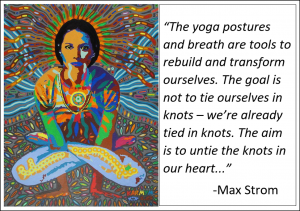Written By: Dipika Delmenico
To retreat is to take quietude for renewal. To reintegrate is to make meaning of, upon re-entry from such act of retreat. Reintegration phases can often feel anything but, like the renewing quietude experienced during retreat.
One of the first questions I ask people on their return from retreat, a transformative experience away from the grunt and grind of the daily schedule at home (whether it be a training, vacation, pilgrimage) is “how is your digestion?”.
Years ago for my 40th birthday, my husband and children gifted me a Pilgrimage to the Heart retreat in the aśram I’d lived and served at in India. It was a silent retreat. With four children at the time, our home was busy and noisy. I yearned for spacious inner silence.
The retreat was divine. The silence was elixir for my soul. While it was, at the time, difficult to leave my family, my young children, I was going to a place of such intimate and deep familiarity, refuge and renewal.
On returning home however, I felt the immediate dispersion of the renewal I’d acquired during retreat. I did not wish to dilute the expansion and joy I’d experienced. However, the contrast of worldly life as a householder was intense and it was difficult to hold.
My husband laughed at the wide eyed expression I wore as I sat in our family vehicle driving down the coast from the airport, wedged between children all talking at once and yearning for my attention. It was wild and I love the symphony but slow down …. I was assimilating. My physical body had only just landed. My soul, I’m not sure had yet fully arrived!
A week or so after returning from retreat, I observed that I became Irritated with one of the retreat’s teaching Swamis. I was annoyed that he had not addressed how the participants could support and assimilate the heightened retreat experiences, on return to our homes in different corners of this magnificent globe. I was irritated and made him the object of my discontent while I struggled to digest and find ways to make meaning of my experiences. Leaving the cocoon of the retreat to the demands of worldly life. “Did he truly have any understanding of what I was going home to? Toddlers, nappies, teenagers, tantrums, juggling shift working partner with my own clinical practice, international distributorship business, baking, hands on mum, running a house, a rural property”. Oh yes, I was cranky. How could I hold this expansive, loving space. Where was the time in my day to devote to my own practices?
This was a story I was creating. Everybody has their own story. I acknowledge and honour that each of you have your own individual demands, challenges and triggers.
The truth is whether you take retreat for a day, a weekend, a week or longer, the emerging is delicate and sensitive. If not managed with considered sensitivity there can be discord. Disharmony between where you find yourself and where you have been. Contrast in the environment, company, daily schedule, the satsang.
When you place yourself in an intentional environment and circumstances like retreat, you can experience an activation, mobilizing even eliminating the accumulated residue of life. There can be a purification of the different sheaths of yourself, the kośas.Your more subtle layers, sheaths or bodies. Those that are not visible but are part of your wholeness.
Often people have new experiences on retreat. It may be feeling and meeting whole new frontiers and sensations within yourself. This can be peaceful, blissful, loving, painful, irritating, frightening, overwhelming, sad but oh so alive!
If the environment is one that fosters spaciousness, safety, restoration and ease there can be an opening of you. A heart opening if you will that sees you even MORE loving and sensitive to all impressions you encounter. While in the cocoon of retreat it can be heightened in a way that feels, well good.
Then this precious time comes to it’s natural close and you emerge. You may emerge somewhat fine tuned in resonance. There’s a moment of spark when your resonance and nourished state of being meets with that of the world, which may not have changed in resonance with you. It can be a moment of friction, perhaps even tension or chaos. It can be a moment of great compassion, love, acceptance depending on you and your circumstances.
Of course it looks different for all. Perhaps it’s smack back in a traffic jam, deadlines, demands and expectations, running, juggling, same old patterns emerging, the inner clutter, lack of silence and noice jangling the nerves. And, that sweet, sweet heart space slipping from your grasp. And, be gentle and loving with yourself, for it could be the contrast between your state and those you love, perhaps family, friends, work colleagues.
Being able to digest everything you are feeling, experiencing is key to how you transmute the qualities of your retreat time. You’ll be digesting on all levels of your being. Physically, emotionally, mentally, soulfully there will be a need to fully digest.
Breaking down, assimilating into a substance that nourishes all aspects of you, understanding, making sense of, reflecting and integrating will be inwardly occurring. Having an awareness of this, eating and living in a way that supports this process is key to how you sustain all the gifts of your retreat period. Whether it’s been for a day or a year, the same principal applies. Whatever your circumstances, this applies to you. To understand these principals in practical and profound, yet simple and effective ways I encourage you to read the Chapter on digestion in my best selling book The Ayurvedic Woman.
There are simple, effective and practical ways you can support how you digest these experiences. Eat foods that are warming, easily digestible and nourishing. That includes more cooked foods and less raw foods. YES, that’s right. Soupy stew like one pot meals and soups are perfect. Slow cooked is great. Raw foods have more nutrient dense energy but are less nourishing for this time as they require far more digestive energy and power to transform into a substance that is nourishing for your body and being.
In addition, sip on ginger tea after meals to bolster your digestive fire. If you are feeling like there’s a lot of gas and wind in your gut, your mind and you are overthinking, over emotional or over sensitive then start the day with drinking a cup of hot water with a teaspoon of ghee to pacify you.
And, massage yourself with warm sesame oil before you take bath or shower to nourish your nervous system and impart strength and grace to reintegrate well.
May your digestion be strong and bright, your resonance light.
About Dipika:
Dipika Delmenico is an Ayurvedic Medicine Practitioner, Anthroposophic Naturopath, Yoga of Sound teacher, Speaker and Author. She’s practiced clinically for more than 20 years, treating thousands of patients globally with holistic healing wisdom and Mantra. Dipika is a best selling author of The Ayurvedic Woman and Shine Your Light. She’s the founder of Conscious Woman Rising and The Radiant Woman Foundation; holistic practitioner trainings, wellness courses and programs.
Dipika works therapeutically with Mantra and Sacred Sound as the original medicine, and medicine of our future, integrating and bridging physical and spiritual sciences for true healing potential.
Dipika is in service to the renewal of ancient healing mysteries and healing the divine feminine in each of us and our planet.
You can download my free ebook A-Your-Veda: Your inner roadmap treasure on dipikadelmenico.comfor more tips and tools to support you.










